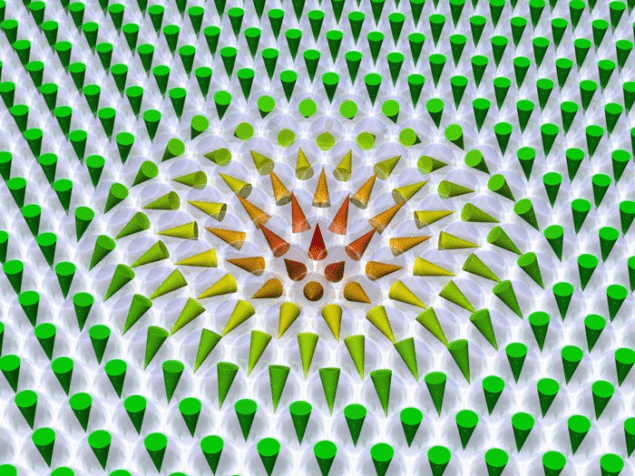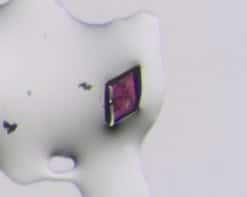
Skyrmions are small magnetic vortices that occur in an astonishingly wide range of materials and they were first discovered about a decade ago. They can be imagined as 2D knots in which the magnetic moments rotate about 360° within a plane. They could form the basis of future magnetic data storage technologies that have a higher density than today’s disk drives. This is because they can be made much smaller than the magnetic domains used in these devices and they can be controlled efficiently with spin currents.
“Skyrmions usually exist in a single thermodynamic parameter range (that is, a certain temperature and magnetic or electric field range). Indeed, this is the case for all the materials in which they have been found so far,” explains physicist Christian Pfleiderer of Munich Technical University, who led this research study. “In a way, this represents an important constraint for when it comes to manufacturing and tailoring skyrmions since the only way to stabilize them is to find the exact physical parameters (pressure, strain, or field for example) at which they occur.
Two disconnected parameter regimes
“We have now discovered two disconnected parameter regimes in one and the same material (namely Cu2OSeO3) with different skyrmion phases. These two phases are stabilized by different mechanisms but are nevertheless active at the same time.”
The first skyrmion phase in this material, which was discovered in 2012, exists at high temperatures near the helimagnetic to paramagnetic transition when a small magnetic field is applied. This phase is isotropic (it does not matter in which direction the field is applied with respect to the crystal structure).
“The second phase, which we discovered in our work, exists at low temperatures at the border between the so-called conical phase (a type of ‘spin-flop’ phase) and the field polarized (ferromagnetic) state,” explains Pfleiderer. “This phase only shows up when we apply a magnetic field along the cubic <100> axis in the material.”
“Something very unexpected and odd”
This phase was discovered by the lead author of the study, Alfonso Chacon, while he was investigating the metastable properties of the high-temperature skyrmion phase. “This metastable behaviour is interesting because it allows us to determine the energetics and mechanisms of how stable skyrmions are and how they are created and destroyed (known as topological protection and unwinding, respectively),” he explains. “Using a technique called small-angle neutron scattering (SANS), I systematically tracked the magnetic order in Cu2OSeO3 over a wide range of temperatures (0 to 50 K) and magnetic fields ((0 to 120 mT) parallel to the <100> crystal axis. I discovered that something very unexpected and odd was going on.”

Talking skyrmions in Columbus, Ohio
This second phase is in fact stabilized by magnetic anisotropy in this cubic material, Pfleiderer tells Physics World. “We used to think that anisotropy did not play an important role here (because it is very weak), but it turns out that it does. We have managed to explain this new phase with all its associated details in remarkable agreement with experiment, thanks to our colleagues in Cologne and Dresden who proposed the detailed interpretation and also performed rather tricky Monte Carlo simulations.”
Generating skyrmions might be even easier than we think
“The discovery means that it might be much easier to generate skyrmions than we thought,” he adds. “Even very weak magnetic anisotropies might do the trick, if they are carefully selected. Our study also made us realize that several mechanisms may be strong enough in one and the same material, which means that they could appear under many more different conditions. We expect that this will be extremely useful for tailoring skyrmions to specific applications.”
The finding is also important from a fundamental point of view. “For example, we are now asking ourselves the question: how does the topological protection differ between the different phases in Cu2OSeO3 and is it possible to switch between the two?”
The researchers, reporting their work in Nature Physics 10.1038/s41567-018-0184-y, say they are now busy with measurements of bulk properties, magnetic force microscopy, magnetic resonance and resonant elastic X-ray scattering on the material to better understand its thermodynamics and morphology (domain patterns and defects in the magnetic texture). “We have also started to look for further examples of such two (and more) skyrmion phases in other materials, having now understood what to look out for,” adds Pfleiderer.



